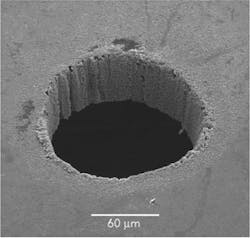Micromachining with picosecond laser pulses
Lasers are powerful tools for micromachining applications. A focused laser beam can easily be concentrated onto a target of a few microns in diameter (or a laser-illuminated mask can be imaged onto the work piece with a high-resolution objective). The laser material interaction in this target area will be controlled by parameters such as wavelength, pulse energy, and pulse duration, which determine peak power density, etc. Certain sets of parameters can cause thermal effects for marking, cutting, drilling, annealing, hardening, etc.
Non-thermal effects on the material can be triggered using high-energy UV photons in ns pulses from excimer lasers (mostly in mask imaging arrangements)—for instance, to ablate thin layers of polycarbonates, or for marking.
Also, non-thermal interaction—cold ablation—has been demonstrated with ultra-short-pulse lasers in micromachining experiments of virtually any kind of material. Femtosecond lasers can reach power densities of hundreds of TW/cm2 and can machine metals, semiconductors, and isolators such as glass or organic material.
More recently, picosecond lasers have been demonstrated to micromachine metals and other industrial materials with the same precision and similar removal rates per pulse. Ps-pulses are short enough to avoid thermal diffusion of energy and reach the peak power densities necessary for these ablation threshold processes. Experiments and theoretical considerations indicate that laser pulses with duration of about 10 ps are ideal for many machining applications[1]. They help to avoid plasma effects in the air in front of the target and the associated beam deformation and scattering.
Picosecond lasers are stable, reliable, and less expensive than femtosecond units. Most importantly, ps-lasers provide high average power (10 W) with very good beam quality (M2 < 1.5) and repetition rates of up to 100kHz, which reduces the cost per part and qualifies this micromachining technology for industrial use. If an amplified ps-laser system is properly conditioned, it can, with each pulse, remove a material layer of a few nm up to a few tens of nm in the focus area, providing excellent software-driven 3D control for an industrial process. This results in material removal rates of up to about 1 mm3 per minute (for steel), with total laser cost of about 25 cents per minute of laser operation.
Such lasers have the potential to be a new, high-quality industrial tool to drill/cut or to structure surfaces of virtually any material (metal, semiconductors, and isolators including glass, diamonds, ceramics, and polymers) in computer-controlled machining systems.
Lumera Laser, for example, demonstrated the first laser of this type, the Staccato, in 2003. This unit offers 10 W TEM00 at 1064 nm, and a pulse length of about 12 ps with 100 µJ at 100kHz, which is sufficient to reach the ablation threshold for virtually any material on target areas of up to about 150 um diameter.
In many cases (even on metals) the combination of short pulse duration and short wavelength has shown the best results in micromachining applications. We describe some of these experimental examples on these pages.
Drilling stainless steel
The use of picosecond laser systems promises precise hole drilling in metals. The edge quality of the metal surface, the quality of the inner hole walls, and high reproducibility in the micrometer range are superior to what nanosecond lasers can deliver. The first step to improve the hole quality is helical drilling, in which the laser beam penetrates the work piece on a helical path and the exit side of the laser-drilled holes appears circular, with sharp edges (see Figure 1).
To achieve such good quality throughout the hole, laser radiation polarization must be adapted during the drilling process. Ripple formation on the hole wall's surface and irregularly shaped holes strongly depend on the polarization in relation to the wall surface. Holes without ripples are achievable by polarization control during helical drilling with special trepanning optics, where the polarization is always oriented orthogonal to the wall.
Due to the very good beam quality (M2 < 1.5) of picosecond laser systems, such ultrashort laser radiation can be focused to spot sizes of 10 µm or less with practical working distance. In one application 50 µm diameter holes were drilled in stainless steel foil of 50-µm thickness. Holes with good edge quality, without burr, and with minimized melt layers were demonstrated. Using a 2 W average power Staccato laser system, a throughput of 180 holes per minute was achieved. In another application, even 30 µm holes were drilled in 25 µm steel foils. By optimizing the processing parameters, a good edge quality also can be observed on the entrance side of the laser radiation (see Figure 2).
Drilling silicon
To determine the potential of high-energy picosecond pulses and compare the readily achievable surface and edge quality with nanosecond and femtosecond pulse results, trepanning of 50 µm thick silicon wafers has been done (see Figure 3).
The samples in Figure 3 show the characteristic influence of the pulse duration on the edge quality and sidewall roughness (without having optimized the process parameters and the achievable results in each case). The mean burr height for 25 ns pulse duration is about five times higher (15–20 µm) than for 12 ps (3–4 µm) in this experimental setup. For 150 fs pulse duration, nearly no burr can be observed. The sidewall surfaces show similar dependence on the pulse duration: with 25 ns pulses, an extremely rough surface forms. Using ps- and fs-pulses, small grooves along the walls are observed due to the linear beam polarization used in these setups (this polarization influence also exists for ns-pulses but could not be observed due to the rougher melting influence on the surface). Keeping the linear polarization perpendicular to the wall with special trepanning optics or using circular polarization can improve the wall quality significantly (as shown in a following example).
High-frequency technology requires that electronic components pass through holes in silicon wafers. Etching technologies can hardly produce these holes. Using a Staccato laser system with 5 W average power, holes of 2mm diameter were drilled through a 300-µm thick silicon wafer. To machine a 2mm hole takes only a few seconds. Figure 4 shows well performed edge and hole wall quality (this sample was machined with circular polarization).
Drilling ceramic and glass
Ultrashort laser pulses in the ps- or fs-regime easily reach power densities in the terawatts-per-square-centimeter range when focused on the material surface. In materials where no free electrons are present, the energy of the ultrashort laser pulses is deposited due to multiphoton and electron-impact absorption or interband transitions. Therefore, ultrashort pulse lasers can process very hard or transparent materials, which are not easily machined by conventional lasers.
Laser machining of ceramics is chosen when tight tolerances, small hole diameters, or complex cut patterns must be achieved. Figure 5 shows a 1mm diameter hole drilled in a 200-µm thick ceramic sample using a Staccato laser system at 10 W average power in about 8 seconds. Due to the non-thermal ablation process, no thermal cracks, burr, or debris were present in the vicinity of the laser-machined hole.
Borosilicate glass was processed with the third harmonic radiation of the IR picosecond laser. Using 2 W average power at 355 nm, 20 holes per minute were machined. Figure 6 shows the good edge quality with minimal heat affected zone and no cracks or chipping.
Cutting stainless steel
A femtosecond laser system is currently used to cut 100 µm stainless steel sheets to produce masks for production processes in the electronics industry. Using a femtosecond system with 0.37 W average power and with 1 kHz repetition rate, it takes almost one hour of processing time to machine a square mask of 20×20 mm2. The same pattern was cut by the Staccato picosecond laser system using a repetition rate of 50 kHz and 0.85 W average power, and processing time was reduced by a factor of 6 (see Figure 7).
Cutting silicon
Current technology to cut silicon wafers is the use of cut-off wheels fitted with diamond plates on their cutting edges. For future requirements such as smaller kerfs and the cutting of very thin wafers with the same high cutting edge quality, the use of laser radiation is under development [3, 4]. Here, the kerfs between the ICs have to be as small as possible to optimize the packing of the chip on the wafer. Additionally, a high-quality cutting edge is required to avoid post-processing. The use of femto- and picosecond laser pulses (Figure 8) minimizes the formation of cracks near the cutting edges and no cleaning or other post-machining processes are necessary.
Surface structuring: modification of metallic surfaces
Using laser radiation, nearly every kind of structure in the range of micrometers can be realized with high reproducibility. In fluidics, investigations deal with the reduction of the flow resistance on turbine vanes or wings. Therefore, the use of extensive rib-structures, so-called riplets, on the surface of fluidic systems is in development. Such structures, as shown in Figure 9, laminate the turbulent layer between the surface and the surrounding flow.
These exemplary rib-structures have been realized using a Staccato with pulse duration of about 12 ps. Such short pulse duration is necessary to avoid thermal damages such as melting phases along the irradiated area on metallic surfaces. Also the formation of burr between machined and un-machined material can be minimized [5, 6]. By scanning the surface with a defined gap between each line, the scanning speed was 1 mm/s for the lower and 100 mm/s for the structures shown in the upper photos.
Machining of carbide metal
Due to its mechanical hardness (>1300 kp/mm2) and high abrasion resistance, carbides are suitable for machining nearly every kind of steel, alloy, and cast iron. The durability of such cutting inserts and the quality of the produced components depend on the geometry and surface of the cutting edge. The rounding of cutting edges consists of two essential components: the rounding radius and the edge geometry. Different rounding radii are achievable by variation of the laser output power and/or the feed rate. The edge geometry has to be adjusted to the requirements of the different chip-removing processes. Thus, the cutting force or the surface quality of produced components can be influenced. Additionally, the edge geometry must be adapted to the mechanical hardness of the machining material within the chip removing process [6].
The edge in Figure 10a has been machined using a focal diameter of 30 µm combined with low pulse energy. This leads to a smoothing effect along the cutting edge due to the very low ablation rate. The resulting radius is between 2 and 10 µm, which is effected by the rough edge geometry of the original edge. A larger rounding radius of about 45 µm with the same surface quality is shown in Figure 10c. Here, higher pulse energy has to be used due to the bigger spot size. This work is founded by the Federal Ministry of Education and Research (BMBF) within the project "GEOSPAN—generation and measuring of the micro geometry on cutting tools" (www.geospan.de).
These applications show the potential of using high-repetition picosecond pulses for micromachining with high quality and efficiency. Pulse duration in the range of 12 ps is useful to minimize thermal damage and burr formation and to avoid disturbing nonlinear effects. Nearly the same edge quality and surface roughness have been achieved as with femtosecond output. The combination of short pulses and repetition rates up to 100 kHz enables efficient ablation processes without post-processing. Further promising applications of picosecond lasers are the direct delamination of metal layers, the removal of thin ITO (Indium Tin Oxide) layers, or laser honing of piston liners of truck engines.
Besides controlled removal of material in electronic and micromechanical applications, the internal alteration of transparent materials (change of index of refraction, color center formation, or modification of specific additives) also is a promising way to create identification or functional structures in materials.
Thomas Herrmann heads the applications lab and Bernhard Klimt is responsible for marketing and sales at Lumera Laser. Frank Siegel is a project manager at the Laser Zentrum Hannover eV.
References
- Dausinger F., H. Hügel, and V. Konov. Micro-machining with Ultrashort Laser Pulses: From Basic Understanding to Technical Applications, in proceedings of Conference ALT 02, 5-20 September 2002, Adelboden (Switzerland).
- Dausinger F. Femtosecond Technology for Precision Manufacturing: Fundamental and Technical Aspects, in RIKEN Review No. 50 (January 2003). Focused on Laser Precision Micro Fabrication (LPM 2002), p. 77—82.
- Ostendorf A., C. Kulik, T. Bauer, and N. Barsch. Ablation of Metals and Semiconductors with Ultrashort-Pulsed Lasers, Improving Surface Qualities of Micro Cuts and Grooves, in proceedings of SPIE Vol. 5340, 2004, p. 153-163.
- Tönshoff H. K., A. Ostendorf, K. Körber, and N. Barsch. Ablation and Cutting of Planar Silicon Devices Using Femtosecond Laser Pulses, in Applied Physics A 77 (2003), p. 237-242.
- Tönshoff H. K., F. von Alvensleben, A. Ostendorf, G. Kamlage, et al. Micromachining of Metals Using Ultrashort Laser Pulses, in International Journal of Electrical Machining, No. 4, January 1999.
- Tönshoff H. K., A. Ostendorf, C. Kulik, and F. Siegel. Finishing of Cutting Tools Using Selective Material Ablation, in proceedings of 1st International CIRP Seminar on Micro and Nano Technology, Copenhagen, Denmark, November 13-14, 2003.













